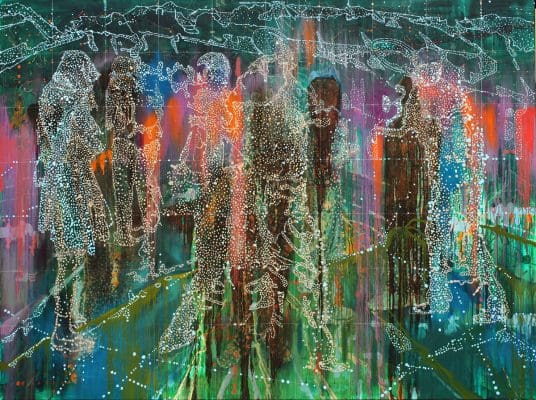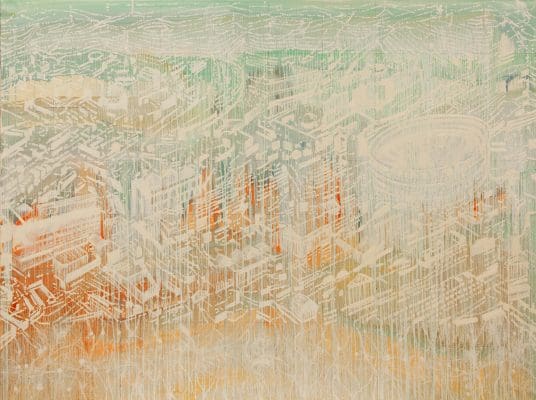
Place-driven Practice
Running for just two weeks across various locations in greater Walyalup, the Fremantle Biennale: Sanctuary, seeks to invite artists and audiences to engage with the built, natural and historic environment of the region.
In the first of a new series of feature articles, we’ve brought together artists and writers who share an interest (besides art). Artist Jon Cattapan sat down with writer Tracey Clement to discuss JG Ballard’s novel The Drowned World and the importance of bearing witness.
At first glance, the painter Jon Cattapan and I don’t have much in common. In 2008 he represented Australia as an official war artist. In 2013 he won the prestigious and lucrative Bulgari Art Award. Cattapan has received numerous grants; more overseas residencies than you can poke a stick at; been the subject of a documentary on ABC television; exhibited extensively both here and around the world; and is a professor and deputy director at the Victorian College of the Arts. In other words, Cattapan is one of Australia’s most consistent, successful and celebrated painters. And I, well… am not. However, we do share an interest (verging on obsession) with JG Ballard’s novel, The Drowned World.

Written in 1962, while the Cold War threatened to turn white hot, this slim sci-fi book is infused with anxiety. Ballard presents a post-apocalyptic vision of the not too distant future in which the planet has been reshaped by rising tides and steadily mounting temperatures. All the major cites of the world are semi-submerged and dominated by enormous plants, giant insects and carnivorous reptiles. And a huge pulsating sun invades the dreams of the remaining human survivors, mesmerising them and driving them first to drink and then increasingly mad.
I initially read the novel in the late 1980s and it reshaped my understanding of our relationship with nature in fundamental ways. Cattapan first read the novel around the same time (1989) and he too has never been the same since. Since 1991 he has been working on a series titled The City Submerged, which has its genesis in the novel, and his 2006 survey show was titled The Drowned World in acknowledgement of the profound impact this text has had on his artistic practice and world-view.
I met with the artist to discuss The Drowned World on a Melbourne day that was so hot, so humid, that it could have been straight out of Ballard’s post-apocalyptic vision. The first line of the novel is, “Soon it would be too hot.” These days, inevitably, Ballard’s novel reads like an uncanny prediction of climate change. I ask Cattapan if that’s what he thought when he first read the book.
“It seemed to me, even at the time, that it was a very prescient book,” he says. “One of the phrases I use to describe the book is ‘reflective space’. Because it provides a way for the viewer to think about a whole lot of things through the reflection of the world that it is giving you. His post-apocalyptic world is reflecting back to us our own world, or, in actual fact, not our own world as it was then, but our own world to come.”
Cattapan recalls that even though the phrase ‘climate change’ hadn’t yet really gained currency, concern over the ozone layer, greenhouse gasses and global warming was mounting. “By the 1980s, there was already ecological consternation,” he points out. But, for his paintings at least, Cattapan was less interested in a future vision of ecological melt-down than in clear and present danger. “I didn’t want my paintings to be sci-fi,” he explains, “I wanted them to be of the here and now.”

Perhaps Ballard’s most evocative image in The Drowned World is the ruined city, a potent symbol of civilisation failed. And in his early City Submerged paintings Cattapan says “it was the dystopian element of the city that interested me.” These initial works are infused with the watery electric energy of summer thunderstorms in the megalopolis of New York, where they first took shape. But they also responded to dystopian elements closer to home, such as the destructive influence of drugs in his local neighbourhood of St Kilda.
In time, Cattapan explains, “The idea of the city lights being like a floating sort of mechanism of data, or electronic markings if you like, overtook the dystopian.” For Cattapan, his later iterations of the City Submerged became “almost celebrations of the city.”
But what links all of the paintings in this ongoing series is Cattapan’s key interpretation of The Drowned World. What struck the artist most powerfully in Ballard’s novel was the contingency, the instability. As he puts it, “Everything is on the verge of just sliding away.” In Cattapan’s The City Submerged paintings electric lights are indistinguishable from reflections cast by leaf-filtered moonlight, and everything is united by watery washes. The artist’s imagery captures something of Ballard’s narrative in which, as Cattapan points out, everything (both the landscape and the psychology of the people) is dangerously fluid. Territory is contingent and people are unpredictable. Cattapan recognised that Ballard was saying something insightful about the human condition, and he was right.
Nearly 30 years after the fact, reading The Drowned World remains a pivotal moment for Cattapan. “It has stayed with me,” he says, “and formed a kind of way of wanting to calibrate the world around me. It is calibrated through the knowledge that everything is in flux, things are contingent, resources are scarce or running out. These are things that I’m interested in thinking about.”
This ongoing concern is evident in Cattapan’s recent work (sometimes collaborative) which deals with contemporary conflict and its repercussions. Cattapan was a war artist in Timor Leste and he continues to travel to, and make work about, political hotspots as the lead investigator of an ARC funded Discovery project which deals with memorialising conflict through contemporary artwork.
Artists may or may not be able to change the world. But, as Cattapan says, “It is very important to bear witness.” Something else on which we fervently agree. Perhaps we have quite a bit in common after all.